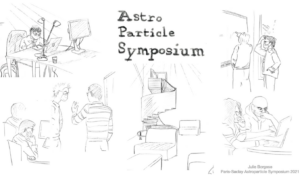The Paris-Saclay Astroparticle Symposium 2021

Sketch from the illustrator Julie Borgese. She was invited to capture the atmosphere of the symposium and to transform scientific concepts into pieces of art.
After being canceled in 2020 due to COVID-19 restrictions, the 2021 edition of the Paris-Saclay Astroparticle Symposium was organised from October 18 to November 26, 2021 at the Institut Pascal of the Paris-Saclay university. The organisation of this event was made possible thanks to support from P2IO, the P2I graduate school of the University of Paris-Saclay, IN2P3, APPEC and CEA. The symposium was a great success: nearly 230 researchers participated either by being present at the Pascal Institute (about 40 per week, many staying for several weeks) or by participating via videoconference.
The symposium was aimed at researchers specialised in the broad field of astroparticle physics, who were invited to come and work at the Institut Pascal in order to initiate, pursue or finalise research projects and publications. The format of the symposium is particularly well suited for this purpose, with a limited number of plenary sessions dedicated to presentations and leaving a significant amount of time reserved for joint work and informal discussions.
Due to the cancellation of the 2020 edition it was decided to extend the duration from the usual 4 to 6 weeks in 2021. Each week focused on specific topics and followed a similar outline: moderated by one or more specialists, informal discussions of about 2 hours on a specific topic triggered very fruitful exchanges and initiated joint works. One day per week was dedicated to presentations by participants who wished to present their work.
The following topics were discussed during the symposium (the details of the different sessions are available on the event website https://indico.ijclab.in2p3.fr/event/7119/):
- Week 1: Galactic Cosmic Rays
- Week 2: Ultra-High Energy Cosmic Rays
- Week 3: Dark Matter: Theories
- Week 4: Dark Matter: Theories versus Experiments
- Week 5: The transient sky (GWs and compact objects, multi-messenger astronomy)
- Week 6: Gravitational waves, theoretical point of view
In parallel, scientific colloquia were organised once a week. Details of the talks can be found at: https://indico.ijclab.in2p3.fr/event/7119/page/122-colloquia
In addition, a series of seven lectures for the general public, given by well-known external speakers, was organised. These lectures took place in the evening at the Institut Pascal and were a great success. Finally, an illustrator was invited to capture the atmosphere of the symposium and transform certain scientific concepts into pieces of art. A first sketch is shown below.
The 2022 edition of the Paris-Saclay Astroparticle Symposium is already in preparation!
Mark your agenda: it will take place from October 31 to November 25, 2022 at the Institut Pascal of the Paris-Saclay university.
Composition of the Paris-Saclay Astroparticle Symposium 2021 organising committee:
- Fabio Acero (AIM, CNRS/INSU)
- Philippe Brax (IPhT CEA)
- François Brun (CEA/IRFU – Department of Particle Physics)
- Olivier Deligny (IJCLab, CNRS/IN2P3)
- Carla Macolino (IJCLab, CNRS/IN2P3)
- Yann Mambrini (IJCLab, CNRS/IN2P3)
- Fabian Schüssler (CEA/IRFU – Department of Particle Physics)
List of scientific symposia :
- The implications of discovery of PeVatrons, by Zhen Cao
- Perspectives in Astroparticles, by Andreas Haungs
- Searching for ultra light dark matter and gravitational waves with atom interferometers, by John Ellis
- Strategies for European astroparticles, by Gianfranco Bertone
- Multi-messenger astronomy including gravitational waves, by Marica Branchesi
- The Cherenkov Telescope array and its science, by Werner Hofmann
List of public lectures :
- Physics in science fiction films, by Richard Taillet
- Why the sun shines, by Roland Lehoucq
- What is the vacuum full of, by Étienne Klein
- A history of the Universe: from the Big Bang to the present day and beyond, by Yann Mambrini
- Seeing and hearing black holes, by Alain Riazuelo
- The arrow of time, from molecular billiards to the dance of stars, by Cédric Villani
- Thirty years of progress in astrophysics, by Hervé Dole



